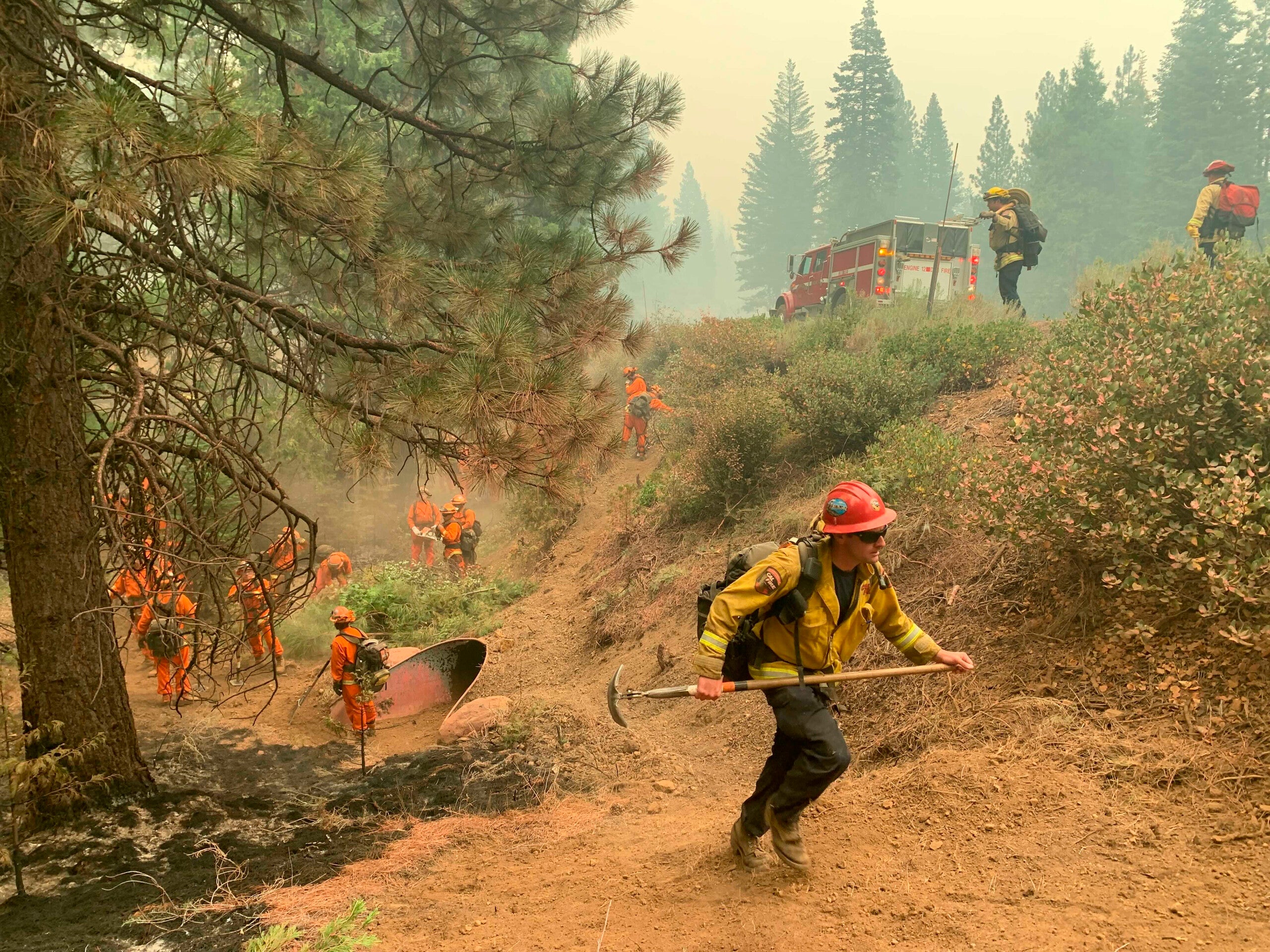Western fires threaten thousands of homes, strain resources
WESTWOOD, Calif. (AP) — A month-old wildfire burning through forestlands in Northern California lurched toward a small lumber town as blazes across the U.S. West strained resources and threatened thousands of homes with destruction.
Crews were cutting back brush and using bulldozers to build lines to keep the Dixie Fire from reaching Westwood east of Lake Almanor, not far from where the blaze destroyed much of the town of Greenville last week.
The entire town of about 1,700 people was placed under evacuation orders Aug. 5 as the blaze inched closer.
To the northwest, the Monument Fire — one of at least three large blazes sparked by lightning last month — grew after destroying a dozen homes and threatened about 2,500 homes in a sparsely populated region. Firefighters said Friday that flying embers ignited spot fires as far as a mile ahead of the main blaze in the Shasta-Trinity National Forest.
They were among more than 100 large wildfires burning in a dozen Western states seared by drought and hot, bone-dry weather that has turned forests, brushlands, meadows and pastures into tinder.
The U.S. Forest Service said Friday it’s operating in crisis mode, fully deploying firefighters and maxing out its support system.
The roughly 21,000 federal firefighters working on the ground is more than double the number of firefighters sent to contain forest fires at this time a year ago, and the agency is facing “critical resources limitations,” said Anthony Scardina, a deputy forester for the agency’s Pacific Southwest region.
More than 6,000 firefighters alone were battling the Dixie Fire, which has destroyed more than 1,000 homes, businesses and other structures and was the largest wildfire burning in the U.S. Its flames have ravaged nearly 845 square miles (2,100 square kilometers) — an area the size of Tokyo — and was 31% contained.
The cause of the fire has not been determined. Pacific Gas and Electric has said the fire may have been started when a tree fell on its power line.
There also was a danger of new fires erupting because of unstable weather conditions, including a chance of thunderstorms that could bring lightning to Northern California, Oregon and Nevada, according to the National Interagency Fire Center.
“Mother Nature just kind of keeps throwing us obstacles our way,” said Edwin Zuniga, a spokesman with the California Department of Forestry and Fire Protection, which was working with the Forest Service to surround the Dixie Fire.
In southeastern Montana, firefighters and residents were scrambling to save hundreds of homes as flames advanced across the Northern Cheyenne Indian Reservation.
The blaze was more than 50% contained. But its southern edge was still burning near the tribal headquarters town of Lame Deer, where a mandatory evacuation remained in place, and a second fire was threatening from the opposite direction.
The fires already had burned or threatened grasslands that many locals with cattle and horses depend upon for their livelihoods, Montana officials said.
Smoke from the blazes grew so thick Friday that the health clinic in Lame Deer was shut down after its air filters could not keep up with the pollution, Northern Cheyenne Tribe spokesperson Angel Becker said.
Smoke also drove air pollution levels to unhealthy or very unhealthy levels in parts of Idaho, Oregon, Washington and Northern California, according to the Environmental Protection Agency.
Hot, dry weather with strong afternoon winds also propelled several fires in Washington state, and similar weather was expected into the weekend, fire officials said.
In southeastern Oregon, two new wildfires started by lightning Thursday near the California border spread rapidly through juniper trees, sagebrush and evergreen trees.
Oregon Gov. Kate Brown declared an emergency for one of the fires to mobilize crews and other resources to the area of ranches, rural subdivisions and RV parks about 14 miles (23 kilometers) from the small town of Lakeview.
Triple-digit temperatures and bone-dry conditions in Oregon, enduring a third day of extreme heat, could increase fire risks through the weekend.
Climate change has made the U.S. West warmer and drier in the past 30 years and will continue to make the weather more extreme and wildfires more destructive, according to scientists.
Dozens of fires also are burning in western Canada and in Europe, including Greece, where a massive wildfire has decimated forests and torched homes.
___
Nguyen reported from Oakland, California. Matthew Brown in Billings, Montana, Olga R. Rodriguez in San Francisco and Gillian Flaccus in Portland, Oregon, contributed to this report.
